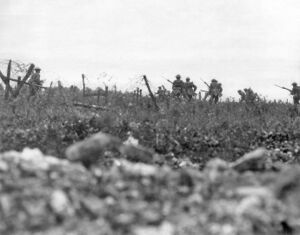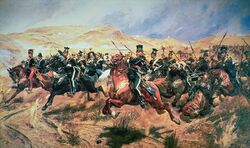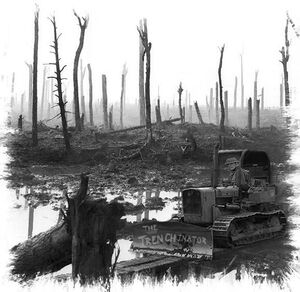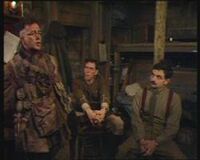Trench warfare
Here's a maths question: what do you get when you have two opposing sides, with the exact same amount of men, firepower, munitions, planes, effort, military tactics, intelligence, resources and total unwillingness to move for anyone else? You get a bloody pointless stalemate, that's what.
But never fear, there is an alternative - trench warfare. This ensures that all the men, firepower, munitions, planes, effort, military tactics, intelligence and resources[1] can alllllllllll be put to use and neither side has to move an inch from where they sit with pride. Basically whoever starves to death first loses.
Stalemates are a waste of time. Before the invention of trench warfare, nations were perfectly happy to cede their part in a war just to avoid total lack of progress for anyone whatsoever, even at the risk of overturning their lands, people and reputation to the enemy scum. But now, the enemy scum can be held permanently at bay with no further risk to your nation's possessions by simply digging down hard at the ground, forming two ditches on either side of a mucky mud-bath of a field, and taking it in turns to feed men to the other side's machine guns.
It may also turn into a massive bloodbath of a field, but there is no point in worrying here (unless you actually own a farm).
History and origins
Wars of the world were at their height in the middle ages. You can keep your Korean conflicts[3] and Seven Years' wars[4], the Medieval ages knew how to fight a battle. Shining knights in armour, longbows firing archers, spearmen piking catapults, etc, etc. Such primitive weaponry, yet the armies of the age found the time to beautify chivalry in battle, induct heroic heroes in the annals of heroism, engraved swords that represent the ivy of death to constrict the evil enemy. And who could forget the scores of men that used to show up for the morning battle? 120,000, 130,000 or even 150,000 men used to meet another just in the hopes of battering a pillock for being born on the wrong side of the border. It's like watching Leeds play away.
And then White people decided to use gunpowder for war instead of celebration. It ruined everything that made war so great, quite frankly. Horsemen were no longer allowed to gallop jubilantly in the direction of the on-foot enemy with intention to stick a lance in someone's miserable face, because he is now immediately at due risk of getting shot, just as he even gets close to anyone. All the glory of running to another to exchange swipes of the blade, completely gone.

This was replaced by the early period of gunpowder where cannons were heavily relied on for any tactical advantage concerning gunpower. Handguns existed too, but they were so inaccurate a soldier could only hope to pierce the sky or scare off a naive native in whatever area he was colonising at the time. Even when the guns were upgraded for better accuracy, they just too so long to reload. Gunmen took organised positions similar to everyone else on the field, forming a queue (like in the post office) to take shots at wherever the enemy are anyway. Once fired, the gunman is sent to the back of the queue (just like in the post office), unless he was shot beforehand (again, just like in the post office), reloads and rejoins the queue to have another crack. These manoeuvres are all done completely out in the open, so you were at full risk of getting killed by more accurate, and yet even deadlier, weapons.
Now it was the time of hiding behind objects and letting go off a potshot every now and then. This came around just after the mid 1800s or so. The Crimean War and the American Civil War both had various flirtations with trench warfare, and at last, for the first time since the middle ages, things were looking up. The power of the redoubt (a sort of temporary fortress[5], the successor to the bouncy castle[6]) was diminished by yet more accurate and strategic arrangement of cannons, some of which were starting to turn into the modern variants of artillery that would be used extensively in WWI. And by extensively, I mean they enlarged the barrel so shells could be fired at the general direction of an enemy nation, straight from home ("hoping for the best" was a necessary addition, however, further wars were instigated when shells flew into other nations).
But by the early 20th century it became clear that modern and accurate bolt-action rifles (with easier loading times), highly powerful machine gun emplacements and more obliquely ranged cannons would create a scene for war impervious to any old field that all land-based mêlées and shootouts had been waged upon until then - trench warfare simply came along naturally. To adapt these new weapons for battle, a regular-joe field would have to be terraformed to accommodate soldiers of warring nations. There are various methods of doing this:
- Mass digging - The most simple yet most popular idea, get a huge digging effort going to develop the land with a carefully planned and heavily structured network of trenches, with stiff wooden planks upholding key parapets for charging-at-the-enemy purposes and underground quarters for sleeping-until-that-happens exercises. Unfortunately, a mass dig tends to give troops the impression that they're digging their own graves, but that's merely a byword for trenches if you ask me.
- Build man-made structures - Combines the above option but with more reinforced defences. More wooden planks are used, which keeps out the dirt and enlivens the trench, and concrete is poured in certain areas for protection against artillery fire and so on. However, the main problem is that adding more wooden planks can shorten the length of the trenches (and therefore the front line) and concrete is just far too much money and hassle. Besides, the above idea should make up for this lack of care in soldier's lives anyway.
- Bulldoze the land - Lacks the god is in the detail finish of the above two options, but is an otherwise ideal choice. Sometimes a rocky, barren plain proves too hard a ground for spades to dig into. Luckily, rocky, barren plains are only encountered in Eastern Europe and nobody will ever need to invade them again. Yet.
- Just shell the hell out of the place until craters form natural points for cover - Not the initial course of plan, but the war effort is eventually reduced to this obvious method. A commanding officer may deign to shell a trench through no man's land to connect his trench with the enemy trench, thus avoiding all the machine guns and mines that irritate his men. If a charge is (somehow!) successful, the triumphant division may find that all the allied artillery shells had missed the enemy trenches by a good length - so upping the amount of shells fired may not be a good idea for morale.
Realistically, any of the four ideas above should work out fine. Hopefully no-one is strafed by enemy fire or bombed to death in the process of digging trenches because that's what'll probably happen there's no risk of that at all.
Usage
Well, the use of a trench is quite clear. I suppose you could think of it as a geographical feature on your ordnance survey that gives you cover from battery shells, that have an annoying tendency to rain down on your position every now and then.
Good trench
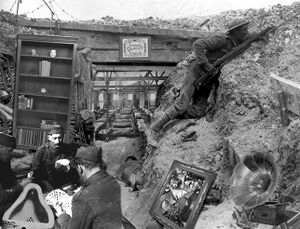
You're standing in your trench, in the exact centre of your assigned area. Note that you are still a good four feet from the parapet that leads out into no-man's land, and that you have a clear wide area of six or seven feet around you. Lots of space to have a game of cricket with the chaps when the artillery is being realigned.
The other men around you are comfy and well adjusted to their surroundings. They are happy and jovial and, when prompted, often blurt out Wilde-esque titbits of wit about the silly war they've just got themselves into. They are well versed in poetry, have regular book club meetings and can argue the finer reasons of allied France's early-1800s re-entry into a constitutional monarchy system[7] after half a century of crass imperialism that had exasperated the nation of la belle. There is always one keen soldier who does an excellent impression of Buster Keaton when moods are (very rarely) low.
The squadron sergeant is a jolly sort of fellow and is very understanding when you wish to give the daily big push a rest for a month or two so you can finish off Charles Dickens' Great Expectations that you've borrowed from the trench library that houses all authors from the renaissance period to the recent impressionist era. The sergeant, in fact, encourages your healthy habit of really sticking into a good book in the trenches and tells you hourly of how he's looking very forward to when you finally finish whatever novel it is you're reading so he can discuss the flow and craftwork of the words, the emotional and relate-able development of the characters, the deep riddles in the plot and so on - he just wants to talk to you about everything in literary English.
Fellow troops very rarely die, and if so, he probably forgot to keep track of his rations or how many cigarettes he was smoking or his thirst level whilst deeply immersed in the story of whatever book he's trying to read in one sitting, so he can talk to the squadron sergeant about it enthusiastically. Maybe one or three will die in the daily skirmish with the enemy, but that is all due to carelessness on both sides - they'll most likely apologise immediately if they accidentally shoot you in the spine, and you'll be expected to shout back not at all, old fellow!" upon falling to the muddy field. If you happen to be in the area when this mysteriously occurs to someone else, you might be expected to carry out his body to the coffin-builders shop just in Trench B which makes luxury coffins fit for soldiers to die in. You can tell the old chap "jolly bad luck, old boy" when he's put in his coffin and you may have a good chance of hearing his droll retort ("Dying? That's the last thing I'll do!"). Burials are 20 miles behind the front line, and therefore it's a good chance for you to get out of the trench, stretch your legs and have a game of tennis on the barracks' veranda with the men as part of the wake festivities.
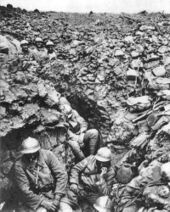
Food rations are plentiful and exuberant, just what the doctor ordered as far as the general in command is concerned. Roasted pheasants, roasted beef, lobster au gratin and buckets of champagne are regular ditties on the menu at teatime, otherwise you may have to make-do with roast Sunday dinner every now and then. Rationing back home takes its toll too, you know. All meals are eaten on the same table as the officers who sit behind the desks back home at the HQ a few miles from the trenches. They're used to eating squarer meals so they might as well eat with the rest of the men.
The enemy are a very accommodating troupe of people and when they're not pretending to put you under fire (to keep up the war atmosphere for the propaganda cameramen), they will most likely send messages, via a fluffy homing pigeon, to your trench, attempting to put you in your place regarding gothic literature that they seem so obsessed with. Nonetheless, they are always charming and polite connoisseurs, even if they are a bunch of Immanuel Kant lovers - sometimes you start to think this war is propagated by literary clashes. They always have a good point though, it can be hard to argue with them over who the best authors are of the previous century.
In general, a good trench in wartime is a cosy, second home with no expense to yourself. If only they were in every war.
Bad trench
This would have to be the worst kind of trench, that is so bad that you seriously think twice about the idea of war and you'd probably stop reading Rupert Brooke's poetry quite abruptly as a result. I've thought about this a lot, I've not really sure I've heard of many trenches that went totally wrong, but I suppose I can have a crack at it. Here we go:
You're standing in your trench, in the exact centre of your assigned area. The parapet of the trench that gives entrance to no-man's land is a worrying half a foot (or less) above your head, and you have about a foot of space between the watering hole that acts as your sleeping space and your entire squadron's latrine, to the ladder that takes you over the top. The limited space offers little time to fret about claustrophobia and cholera.
The other men around you are scattered across the trench and paint a pretty dismal picture to write home about. They are each in deep depression, lost in their surroundings, feel as if the trench gets smaller each day and refuse to talk to another. Attempts to converse with one of them yield no conclusions and they won't even tell you what their first name is, or what they did before the war started. There is always the one adverse soldier who does an unfunny impression of Lord Kitchener when moods are (all the time) very, very low. Everyone tries to chortle at him just to remind themselves of laughter.
The squadron sergeant is the closest person you'll get to an enemy who's not behind a machine gun on the other side. Give the man any excuse to skip the daily push and he'll laugh and spit on the floor to give you something to clean with your uniform. He is a mean, horrible bastard who swears hourly that he hates your guts and would like to see nothing more than your blood mixed in with the sewage on the ditch in the trench that he uses to generate water rations. He probably actually looks forward to seeing you fling yourself out in no-man's land. If you desert or disobey orders, you will most likely be court-martialled and executed by firing squad.
You see fellow troops dying nearly all the time and, if they don't, that's probably because you died before they could. Disease and fear can destroy the immune system and kill you, but most likely you'll be shot to death by heavy machine gun fire or blown to tiny smithereens by landmines in the daily skirmish with the enemy. If you somehow survive and come back, you'll be given a spade and directed to an area of the cramped trench in which to dig another hole. Not for you to gain extra cover from enemy shell fire, but for your dead comrades fallen in battle. Most plots are already occupied and you may find yourself actually digging up bodies of men who died last week. You dig away anyway at the behest of your captain.
Food rations are thin and lack substantial energy properties, which are the only thing the doctor can prescribe for anything and the general in command is probably too lazy to care less. Rations are sufficient initially, but, as time goes by, rations are cut rapidly to the point where meat is rarely served each month. If it is served, it probably doesn't meet dietitians' standard for daily calorie intake, which is too small for soldiers serving in wartime anyway - unless they do absolutely nothing but sit in a trench, so this can work out in the end. However, the meat rations are not usually farmyard-sourced and vegetables are soon replaced by turnips (which also later substitute flour in bread), and then finally weeds from the local area.
The enemy are a very vicious bastion of mooks and, when they're putting you under a hail of bullets (to keep up the war atmosphere for the propaganda cameramen), they will most likely send 500lb shells, via an ugly array of artillery, to your trench, attempting to keep you in your hole full of deep puddles and corpses. Nonetheless, they are always resolute and never stop firing, even if they are a bunch of cunts, quite frankly - sometimes you start to think this war is propagated by social ignorances. They always have a good vantage point, it can be hard to get back at them over which the best empire was of the previous century.
In general, a bad trench is a inescapable hellhole that descends ever further into the earth than Dante ever dared to go.
Of course all of this never happened.
Examples
Crimean War
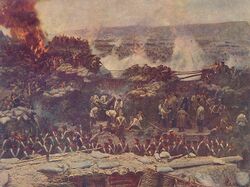
The conflict in what is now southern Ukraine was the first battle to prove fortifications to be nothing but redundant in the face of modern gunpowder and reveal the power of the trenches.
Where redoubts fell, a trench rose from the rubble (well, not "rose" exactly, uh... permeated?) to provide protection. The trenches proved to be too low for cannon fire to hit with aplomb, and the protection from the earth brought natural shelter. Since the Crimea didn't exactly sell mobile forts for the protection of the invading British and French forces, a spade did just as well in this regard.
It's a slight shame this was also the first conflict to be documented via photography. There were some paintings, but now the realities of war would surge past the idealistic imagery propagated from an artist's paintbrush just after his commanding officer peruses a revolver to suggest to the artist to exact his tremendous imagination on the canvas, instead of portraying the truth. However, photographs at this point were in sepia, black and white, or whatever, so the drab, murky, general brownness colours of the rainbow that enlivened the trenches were not shown accurately.
Some battle in the American Civil war... Siege of Petersburg
One of the earliest engagements regarding trenches that I can think would be that beginning part of the film Cold Mountain[8], where Jude Law and the other ones are cowering under cover of the earth or something... I don't remember the name of the battle. Found it[9]. Disregard the previous part.
Anyway, as it does in the film, the Siege of Petersburg sees plenty of young men resorting to trench tactics. Ulysses S. Grant ordered... actually, I don't know anything about this battle, but it did have trenches and that in it.
Um... I'm unsure what to say really. I remember what happens in the film though. Basically there's all these Union troops about to kill the fuck out of Jude Law and his depressed Confederates, who are entrenched from the Yankees. It turns out there was a Union operation stringing a load of explosives under (or near) the trenches of the bored Confederates and then, something about a rabbit, then they all get blown up (except the Union and Jude Law and some others). Then, going in for the kill, the Union charge to polish off the survivors, but clumsily fall in the hole where the trench used to be or something, craters and suchlike. Some sort of obscured mêlée is the result, someone gets stabbed, Jude Law (he's English, for goodness' sake) goes crazy with a buckshot revolver he handily finds on the floor, and then scene changes suddenly, loads of dead Union troops or something (even though they eventually win).
So there you have it. I've no idea what actually happened in the siege itself, but thank god there was a movie, huh? Anyway, it does show the advantage of staying in your trench. Anyone who tries to advance from their trench to the other just get killed regardless of how much they explode the enemy beforehand. Stay in your trench.
Gallipoli campaign
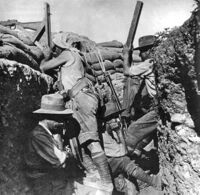
The second year of the Great War. Everyone's dying in wars everywhere and Lord Kitchener wants something done about it. Even Kitchener is concerned by the sudden drop in population in Europe, which was in desperate need for help from bombs and everything. The only solution, of course, is more war, this time relocated to the sunnier shores of Turkey, the peninsular body housing the faltering Ottoman Empire. After all those bloody Turks had only gone and uh... done something... I don't know what they did, but war it was.
This was a prime time opportunity for the ANZAC troops to come along to Europe and do a fair bit of dying everywhere. After all, the allied forces were keenly represented by the British, French and Russians elsewhere in Europe, so the ANZACs had to settle for the rotten apple (coincidentally the army rations) in the Dardanelles, where the British supplies were denied access to Russia (the supplies of which: jewellery for crowns, camphor wood for thrones, ermine for capes, etc, goods that had a long-term future). To aid him in the Dardanelles, Lord Kitchener appointed Sir Ian Hamilton, who himself admitted he knew nothing about fighting conditions in Turkey, nor the armies that peopled the shores. Was this a campaign destined for failure and more death by the hundred thousands?
Well - yeah, actually. Oh well. At least trench warfare was used to a keen extent by the invading ANZAC forces. Men going over the parapet, mown down by machine guns, etc, etc. Whatever.
Battle of the Somme
Full article on the Somme found here.
This is the big one. Quite frankly, all trench battles should adhere to the standards raised in the poppy fields of the Somme.
If the usage of trenches is to be for deterring the enemy, there is no greater example. Very little progress was made during the advances, and when one side decided to cede from the fields, it was done by carefully withdrawing their army with tactical precision, which still prolonged the war by a further two years. On the first day alone, the British army suffered 57,000 casualties. The Germans lost so many on that same day, even the army statistics squadron were killed.
The intensity of WWI trench warfare meant about 10% of the fighting soldiers were killed. This compared to 4.5% killed during WWII. The Somme on its own contributed its fair share of trench deaths that outclasses its successor. Therefore, I certainly know which war I would go back in time to; the Somme is far manlier than anything else in existence.
The trenches in this battle were so effective, that the result for the Somme is considered by historians to be indecisive[10]. That's right, despite the efforts from both sides, the trenches ensured total neutralisation to the proceedings. By using trenches, everyone can see that any kind of war can even be averted because it's just a waste of time.
Just like this section here.
Battle of Kursk
This WWII trench battle probably holds the record for longest trench ever built - 3000 miles to be exact. That's mind boggling, even to me. The job of digging it went to the 10,000 Red Army and civilian workers who happened to be in the area, who also went on to lay 1,000,000 landmines. An astonishing 1,500,000 men (a ratio of 2.5:1 of Soviet troops against Nazi troops) took part in this battle, not including the 6,300 tanks (2:1), 35,000 pieces of artillery and mortars (4:1), 5,000 aircraft (almost 1:1) strafed and were shot down in this gargantuan conflict.
Oh and loads died too, I guess. At least this battle showed that even the thinnest of trenches can be the longest, and hold the greatest number of men. Mathematics, eh?
Decline
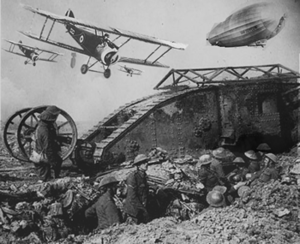
Sadly still, soon after WWII trench warfare thinned out entirely. A lot of suggestions have been made for why this is the case today, but the simple fact is that wars nowadays just don't have as high an attendance record as they used to. Battles have gone from featuring sheer numbers of 30,000 men on 30,000 to 12 men against another 12. Modern weaponry and tactics take so much care to avoid such rough situations in war, that even amateur soldiers know how to avoid using a trench to attain victory in the field.
Tanks ruined everything too. Bumbling over plains and hills alike, tanks reduced carefully lain trenches to mere ditches on the path to the enemy. They tore past anything from rocks to trees, rumbling loudly, leaving behind massive tracks and spoiling your afternoon tea. Tanks... such an appalling idea - a man inside an automatic vehicle covered in heavy armour and a large weapon... What would the horsed knights in chain mail from the middle ages have thought if they saw these infernal machines? They would've been bloody disgusted, I can tell you.
And also since the mid-20th century, trench warfare has been seen as primitive. You are more likely to be considered hi-tech if you brandish a bronze shield in a firefight than if you dig a trench for the protection of yourself and everyone else. Trenches came back briefly as a North Vietnamese tactic during their war in the 1960s, but they were brushed aside by the invad- oh wait, the North won that didn't they? I guess the future isn't all bad for trench warfare then. Maybe some huge war somewhere in the 2010s will see it make a return...
Notes
- ↑ All items not included
- ↑ http:/poetlowrate.co.uk/tennyson/
- ↑ http://themanywarsusahaslostinhistory.org/korea/
- ↑ http://restoreprussia.de/sevenyearwar/
- ↑ http://castlesinsmallparcels.co.uk/redoubts/
- ↑ http://castlesinsmallparcels.co.uk/bouncycastles/
- ↑ http:/chocolatebourbons.fr/reignoffrance/
- ↑ http://givejudelawanoscar.com/
- ↑ http://battlefieldsofamerica.com/petersburg/
- ↑ http://battleresults.org/somme/
| Featured version: 10 April 2010 | |
| This article has been featured on the main page. — You can vote for or nominate your favourite articles at Uncyclopedia:VFH. | |
